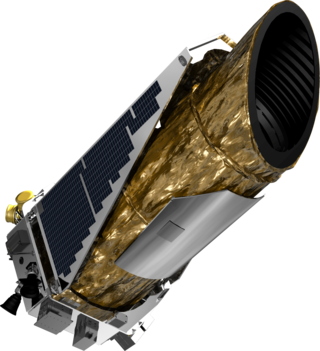
An exoplanet or extrasolar planet is a planet outside the Solar System. The first possible evidence of an exoplanet was noted in 1917 but was not then recognized as such. The first confirmation of the detection occurred in 1992. A different planet, first detected in 1988, was confirmed in 2003. As of 1 May 2024, there are 5,662 confirmed exoplanets in 4,169 planetary systems, with 896 systems having more than one planet. The James Webb Space Telescope (JWST) is expected to discover more exoplanets, and to give more insight into their traits, such as their composition, environmental conditions, and potential for life.

A terrestrial planet, telluric planet, or rocky planet, is a planet that is composed primarily of silicate, rocks or metals. Within the Solar System, the terrestrial planets accepted by the IAU are the inner planets closest to the Sun: Mercury, Venus, Earth and Mars. Among astronomers who use the geophysical definition of a planet, two or three planetary-mass satellites – Earth's Moon, Io, and sometimes Europa – may also be considered terrestrial planets. The large rocky asteroids Pallas and Vesta are sometimes included as well, albeit rarely. The terms "terrestrial planet" and "telluric planet" are derived from Latin words for Earth, as these planets are, in terms of structure, Earth-like. Terrestrial planets are generally studied by geologists, astronomers, and geophysicists.

In astronomy, a transit is the passage of a celestial body directly between a larger body and the observer. As viewed from a particular vantage point, the transiting body appears to move across the face of the larger body, covering a small portion of it.

The Kepler space telescope is a defunct space telescope launched by NASA in 2009 to discover Earth-sized planets orbiting other stars. Named after astronomer Johannes Kepler, the spacecraft was launched into an Earth-trailing heliocentric orbit. The principal investigator was William J. Borucki. After nine and a half years of operation, the telescope's reaction control system fuel was depleted, and NASA announced its retirement on October 30, 2018.

An exomoon or extrasolar moon is a natural satellite that orbits an exoplanet or other non-stellar extrasolar body.

Any planet is an extremely faint light source compared to its parent star. For example, a star like the Sun is about a billion times as bright as the reflected light from any of the planets orbiting it. In addition to the intrinsic difficulty of detecting such a faint light source, the light from the parent star causes a glare that washes it out. For those reasons, very few of the exoplanets reported as of January 2024 have been observed directly, with even fewer being resolved from their host star.

A Super-Earth is a type of exoplanet with a mass higher than Earth's, but substantially below those of the Solar System's ice giants, Uranus and Neptune, which are 14.5 and 17 times Earth's, respectively. The term "super-Earth" refers only to the mass of the planet, and so does not imply anything about the surface conditions or habitability. The alternative term "gas dwarfs" may be more accurate for those at the higher end of the mass scale, although "mini-Neptunes" is a more common term.

Kepler-9 is a sunlike star in the constellation Lyra. Its planetary system, discovered by the Kepler Mission in 2010 was the first detected with the transit method found to contain multiple planets.

Kepler-9c is one of the first seven extrasolar planets, exoplanets, discovered by NASA's Kepler Mission, and one of at least two planets orbiting the star Kepler-9. Kepler-9c and Kepler-9b were the first exoplanets confirmed to be transiting their star. The planet's discovery was announced by the Kepler Mission team on August 26, 2010 after its initial discovery by Kepler. At the time, it was one of 700 planetary candidates noted by Kepler.

An exoplanet is a planet located outside the Solar System. The first evidence of an exoplanet was noted as early as 1917, but was not recognized as such until 2016; no planet discovery has yet come from that evidence. What turned out to be the first detection of an exoplanet was published among a list of possible candidates in 1988, though not confirmed until 2003. The first confirmed detection came in 1992, with the discovery of terrestrial-mass planets orbiting the pulsar PSR B1257+12. The first confirmation of an exoplanet orbiting a main-sequence star was made in 1995, when a giant planet was found in a four-day orbit around the nearby star 51 Pegasi. Some exoplanets have been imaged directly by telescopes, but the vast majority have been detected through indirect methods, such as the transit method and the radial-velocity method. As of 1 May 2024, there are 5,662 confirmed exoplanets in 4,169 planetary systems, with 896 systems having more than one planet. This is a list of the most notable discoveries.

Kepler-10b is the first confirmed terrestrial planet to have been discovered outside the Solar System by the Kepler Space Telescope. Discovered after several months of data collection during the course of the NASA-directed Kepler Mission, which aims to discover Earth-like planets crossing in front of their host stars, the planet's discovery was announced on January 10, 2011. Kepler-10b has a mass of 3.72±0.42 Earth masses and a radius of 1.47 Earth radii. However, it lies extremely close to its star, Kepler-10, and as a result is too hot to support life as we know it. Its existence was confirmed using measurements from the W.M. Keck Observatory in Hawaii.

Kepler-10, formerly known as KOI-72, is a Sun-like star in the constellation of Draco that lies 607 light-years from Earth. Kepler-10 was targeted by NASA's Kepler spacecraft, as it was seen as the first star identified by the Kepler mission that could be a possible host to a small, transiting exoplanet. The star is slightly less massive, slightly larger, and slightly cooler than the Sun; at an estimated 11.9 billion years in age, Kepler-10 is 2.3 times the age of the Sun.

Kepler-11b is an exoplanet discovered around the star Kepler-11 by the Kepler spacecraft, a NASA-led mission to discover Earth-like planets. Kepler-11b is less than about three times as massive and twice as large as Earth, but it has a lower density, and is thus most likely not of Earth-like composition. Kepler-11b is the hottest of the six planets in the Kepler-11 system, and orbits more closely to Kepler-11 than the other planets in the system. Kepler-11b, along with its five counterparts, form the first discovered planetary system with more than three transiting planets—the most densely packed known planetary system. The system is also the flattest known planetary system. The discovery of this planet and its five sister planets was announced on February 2, 2011, after follow-up investigations.
A Kepler object of interest (KOI) is a star observed by the Kepler space telescope that is suspected of hosting one or more transiting planets. KOIs come from a master list of 150,000 stars, which itself is generated from the Kepler Input Catalog (KIC). A KOI shows a periodic dimming, indicative of an unseen planet passing between the star and Earth, eclipsing part of the star. However, such an observed dimming is not a guarantee of a transiting planet, because other astronomical objects—such as an eclipsing binary in the background—can mimic a transit signal. For this reason, the majority of KOIs are as yet not confirmed transiting planet systems.

The NASA Exoplanet Archive is an online astronomical exoplanet catalog and data service that collects and serves public data that support the search for and characterization of extra-solar planets (exoplanets) and their host stars. It is part of the Infrared Processing and Analysis Center and is on the campus of the California Institute of Technology (Caltech) in Pasadena, CA. The archive is funded by NASA and was launched in early December 2011 by the NASA Exoplanet Science Institute as part of NASA's Exoplanet Exploration Program. In June 2019, the archive's collection of confirmed exoplanets surpassed 4,000.

Kepler-62 is a K-type main sequence star cooler and smaller than the Sun, located roughly 980 light-years from Earth in the constellation Lyra. It resides within the field of vision of the Kepler spacecraft, the satellite that NASA's Kepler Mission used to detect planets that may be transiting their stars. On April 18, 2013, it was announced that the star has five planets, two of which, Kepler-62e and Kepler-62f are within the star's habitable zone. The outermost, Kepler-62f, is likely a rocky planet.

Kepler-90, also designated 2MASS J18574403+4918185, is a F-type star located about 2,790 light-years (855 pc) from Earth in the constellation of Draco. It is notable for possessing a planetary system that has the same number of observed planets as the Solar System.

Kepler-90h is an exoplanet orbiting within the habitable zone of the early G-type main sequence star Kepler-90, the outermost of eight such planets discovered by NASA's Kepler spacecraft. It is located about 2,840 light-years, from Earth in the constellation Draco. The exoplanet was found by using the transit method, in which the dimming effect that a planet causes as it crosses in front of its star is measured.

HATS-36b is a gas giant exoplanet that orbits an F-type star. Its mass is 3.216 Jupiters, it takes 4.2 days to complete one orbit of its star, and is 0.05425 AU from it. It was discovered on June 12, 2017 and was announced in 2018. Its discoverers were 23, namely Daniel Bayliss, Joel Hartman, George Zhou, Gaspar Á. Bakos, Andrew Vanderburg, J. Bento, L. Mancini, S. Ciceri, Rafael Brahm, Andres Jordán, N. Espinoza, M. Rabus, T. G. Tan, K. Penev, W. Bhatti, M. de Val-Borro, V. Suc, Z. Csubry, Th. Henning, P. Sarkis, J. Lázár, I. Papp, P. Sári.























